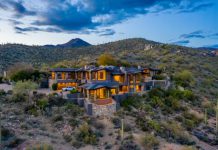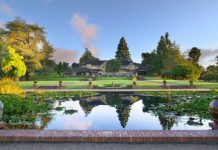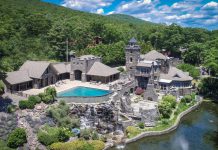A look Into the Future and a Reflection of the Past
By Duncan Forgey

The cobblestone streets are alive with activity. Inviting storefronts act as magnets to the crowd of tourists and locals who frequent its streets. Sandaled feet, bikes and trams traverse the intersections and sidewalks each day. Musical rifts and exotic aromas waft through the air, blown by a gentle onshore breeze. It is a time of nostalgia as the pulse of old Newport Beach has once again come alive.
The city hall has vacated to its new digs in Newport Center, replaced by an attractive and soulful combination of retail and public access walkways and mini parks. New to the area are antique stores, interesting restaurants and a high-end boutique hotel, further surrounded by an eclectic group of mom and pop businesses from a model shop, and bookstore to an ice cream parlor and toy store. Street musicians work the corners at night spotlighted by authentic old street lamps that are reminiscent of the neighborhood’s glory days. Smiles are the dress of the day.
Where is this magical place? It sounds like the Gas Lamp District of San Diego or Seventh Street in Long Beach. or many places east of California. Redevelopments like this are key to the revitalization of historical neighborhoods throughout the country.
Newport Beach’s own Cannery Village and Lido Village has this potential. Even as the historical center of our beloved city, the villages have been all but forgotten in Newport’s addiction to newness and neon lights. Neglected by local politicians in lieu of the east side of the city, the villages have slipped into disrepair.
Ross Perot was famous for asking “… can you hear that great sucking sound?” regarding U.S. job losses overseas. Newport Beach heard that same sound when jobs, restaurants and businesses were enticed to Fashion Island. Today’s result is an 80% vacancy rate in the Lido Village commercial district. Previous attempts to modernize the area have failed due to unsuccessful negotiations between enthusiastic developers and a stubborn city council.
In its heyday, the two villages were melting pots of blue collar workers and rough-around-the-edges old timers that combined hard work and hard fun to make this neighborhood as unique as any on the coast. It now languishes far behind other beachfront communities up and down the coast.
At the turn of the 20th Century, major land developers in Newport such as Collins, Huntington, Lancaster and Hanson knew the key to economic stability in Newport Beach was McFadden’s landing at the Newport Pier. Commercial and residential real estate grew from the oceanfront wharf and the rail line like a spider’s web. Early lots were sold for $40, appreciated to $600 and had risen to $1,800 by 1907. All looked rosy for the “peninsula” until the development boom of Redondo Beach virtually stopped all beach purchases further south. Newport Beach was too far away for the people of L.A. for year round living.
One of the earliest investments in the Villages was the cannery started by O.F. Bennra. Fish were “canned” in glass jars but due to pollution of the bay and economic problems he was eventually shut down. Clarence Reed built an icehouse on 30th Street in 1923 to service the city. For decades, locals would drop coins in a box and listen to the cacophony of metallic clangs as the frozen blocks of ice travelled down a long chute to the street. Newport Beach’s early business dependence on Santa Ana was broken with the opening of the Newport Lumber Company after World War I which provided all the materials for further building in the area.
“Blue collar” Newporters built the Village and hence the fledging city of Newport Beach. White collar professionals were scarce in the town but accessible in Santa Ana and the distant city of Los Angeles. It was not until the 1950s that a stream of doctors, attorneys, bankers and other white collar professionals changed the face of the city. Extraordinary efforts by P.A. “Pappy” Palmer, Earl Stanley and Joe Beek sold the concept of year round living in the neighborhoods of Newport Heights, Balboa Peninsula, Lido Isle and Balboa Island whose residents patronized the villages.
Hosting the City Hall, government offices and police station, the villages were the hub of civic activity. Restaurants like Karem’s, The Stag Bar, Chinese Café, Berkshires, The Sea Shanty, The Crab Cooker and Frank Muldoon’s Stuft T-Shirt were made famous for the best entertainment, drink and good food in town. Other anchor businesses like Baxter and Cicero Sailmakers, Schock Boats and Han’s Dickman Boatyard pumped in money and jobs based upon its marine economy. Retail stores like Richard’s Lido Market, Newport Balboa Savings and Loan, Vincent’s Drugs, the Lido Theatre and Atkinson’s Fine Clothing helped anchor the area as a center of the commerce for the entire city. Sprinkled in were car dealerships, gas stations and boutiques making the villages the finest destination resort in Orange County.
In 1966, the Irvine Company broke ground on the 450-acre site for Fashion Island which was the beginning of the modernization of Newport Beach. This development began a slow and steady decline for the villages which has now realized its final blow with the future completion of the $100,000,000 City Hall. This will have finally left the Village in disarray and has forced a need for redevelopment.
Needless to say, real estate sales in the area have been slow, but a great investment for the future. Currently, storefront after storefront sits empty. Major landowners in the area are trying to work with the city to create a vibrant and meaningful plan for our missing “Downtown Newport Beach.” There are mixed-use commercial/residential lofts that sell in the mid $1,000,000s and up, two high-rise condo buildings that have expansive views in all directions, and nearby is the beach-oriented homes and duplexes of “West Newport,” Ranging from $700,000 to $4,500,000 (oceanfront). Mobile homes can be purchased for under $200,000. The premier property in the area is a bay front, furnished condo with a slip capable of accommodating a 110-foot yacht listed for $7,950,000.
Plans to redevelop the area are being drawn as we speak, the various players have been chosen and the future of the Village can go the way of the exciting redevelopments of other older cities elsewhere or the way of a boring and nondescript collection of new housing and small retail creating the problems reminiscent of the 32nd Street Marina. Let’s suck back the energy of early Newport Beach and its founding fathers. The Villages of West Newport can and should be a vibrant and profitable neighborhood full of hard workers having lots of hard fun.
Information provided by Duncan Forgey, Broker Associate, Forgey Story Group, Prudential California Realty. Call him directly at 949.548.4800. Email him at Forgey5000@yahoo.com. www.DuncanForgey.com



